Lake County looks for input from residents on plan to reduce the number of cars on the road
Feedback on the My Commute Lake County Study is due by April 8.
6:23 PM CDT on March 18, 2024
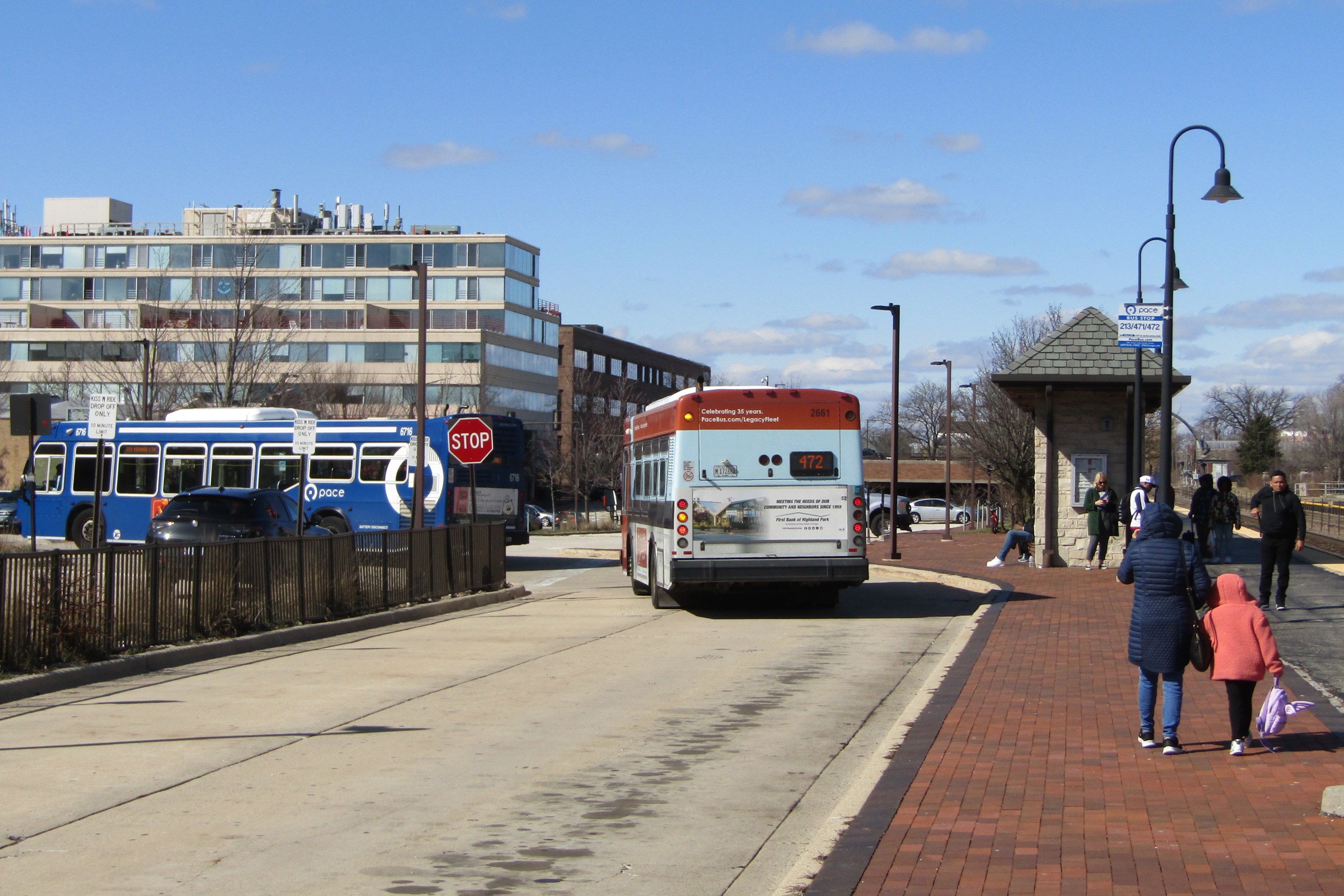
Pace Route 471 and 472 buses leave the downtown Highland Park Metra station, where the boarding area is on the outbound platform. Photo: Igor Studenkov
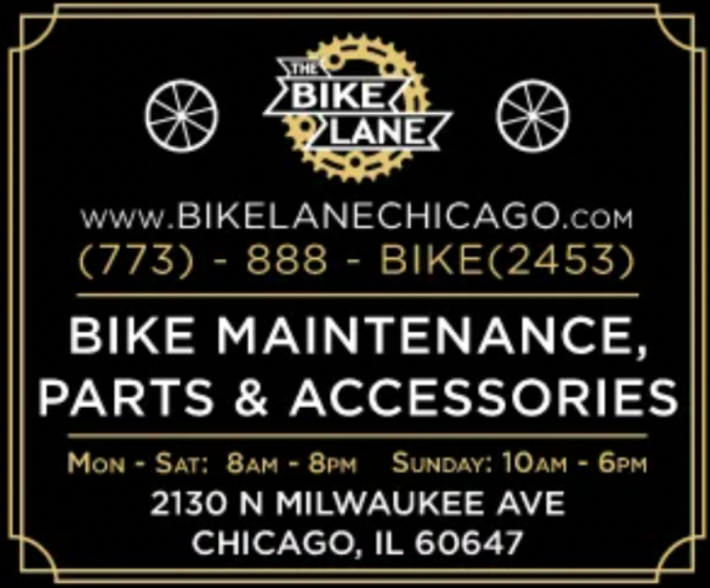
Lake County residents are invited to weigh in on a new plan to fight congestion and pollution from single-occupancy vehicles. The study calls for investing in transit, carpooling-type shared rides, "last mile" options, and pedestrian and bike amenities.
The plan, formally known as The Lake County Single Occupancy Vehicle Reduction Study, and less formally as My Commute Lake County, has been in the works for a while. The Lake County Division of Transportation found that 80 percent of all trips to and from work in the county involved private vehicles, and it wanted to see what it could do to reduce that number. Prior to COVID-19, the department contracted the planning firm AECOM to do a study. The document mentions several adjustments they made to try to take into account the impact of the pandemic.

Notably, the plan recommends investing in "mobility hubs": four Metra commuter rail stations that already have bus and, in some cases, bike-pedestrian trail connections. COVID put the kibosh on the Shuttle Bug program, in which companies subsidized "last mile" commuter shuttles between Metra stations and office buildings. So the the plan calls for investing in ride-hailing (such as Uber and Lyft) and vanpool alternatives.
Other notable suggestions of the study include filling in the gaps in Lake County’s bike-ped path network, upgrading sidewalks, installing bike parking, and improving signage for all transportation modes. The report also recommends looking into replacing "excessive" amounts of surface lot car parking spaces for Metra commuters with transit-oriented developments.
LCDOT officially released the plan on March 6. Residents have until April 8 to submit their comments.
Current conditions
Public transportation infrastructure is fairly uneven throughout Lake County. Waukegan has an extensive Pace Suburban Bus route network, and Highland Park and Pace operate two routes serving the city and the neighboring suburbs. But there are plenty of 'burbs that only have Metra service, or no train or fixed-route bus service of any kind. Some key roadways, such as Milwaukee Avenue, have a significant amount of transit service, but other important corridors, such as Waukegan and Sheridan roads, have little to none.
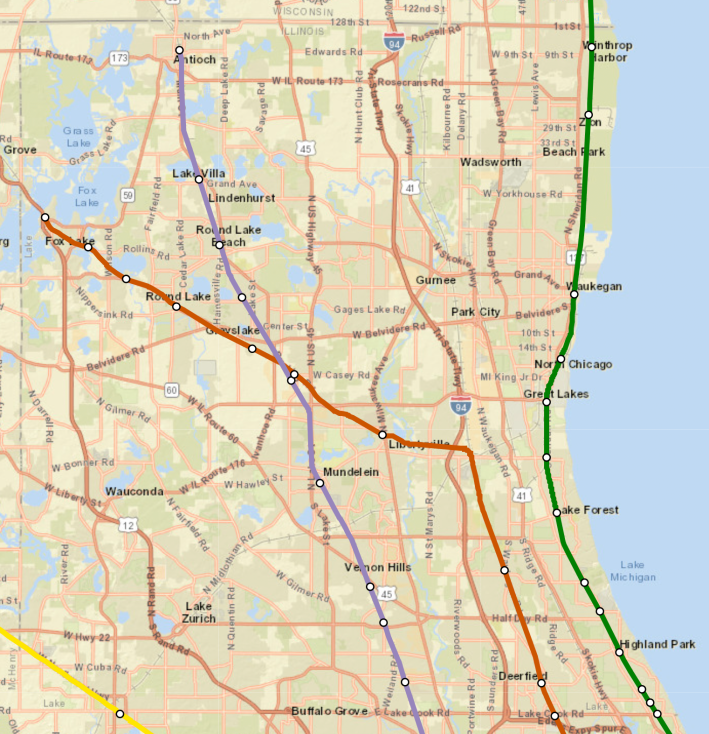
Metra has three lines in Lake County: Union Pacific North, Milwaukee District North, and North Central Service. Even before the pandemic, NCS had less off-peak service than the other two, and no weekend service whatsoever. And UP-N ran fewer trains north of Waukegan than elsewhere along the line. The pandemic-era service reductions exacerbated the problem.
The are similar issues with bike-ped paths. There is an extensive trail network in the affluent North Shore communities. Other suburbs and forest preserves have local bike paths, but connections between those trails are few and far between.
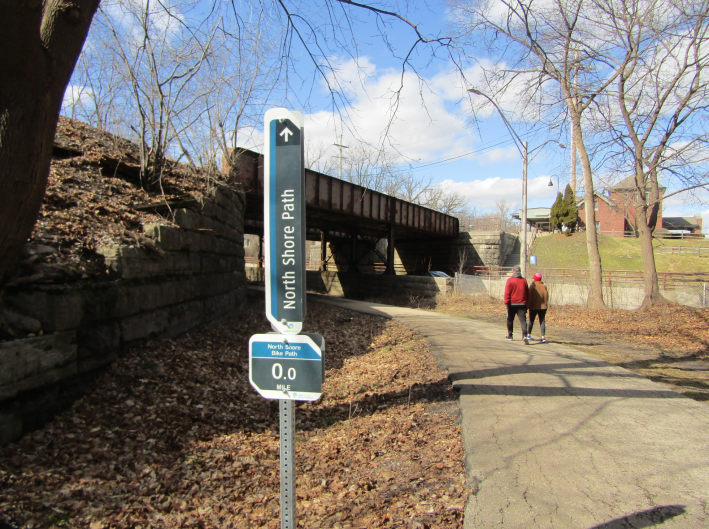
Mobility hubs
My Commute narrowed the list down to four stations: The UP-N line’s Waukegan and downtown Highland Park stations; the MDN line’s Deerfield stop; and the NCS line’s Buffalo Grove station. The study showed that those stations get some of the highest numbers of suburb-to-suburb and reverse commuters in the county. Most Waukegan Pace routes converge at the Metra station. The downtown Highland Park stop offers a relatively quick connection to all three Pace routes that serve the city, especially if you’re using the outbound platform. One of those bus lines, Route 471 Highland Park – Northbrook Court, stops at Deerfield station’s main commuter parking lot east of the outbound platform.
Buffalo Grove station has a bus turnaround at the north end of the outbound platform, where routes 234 - Wheeling – Des Plaines, 272 - Milwaukee Avenue North, and 626 - Skokie – Buffalo Grove Limited stop during rush hour. But the study points out that wayfinding is an issue. Because the turnaround is so far from the station house, it’s easy to miss unless you know where it is.
Some recommendations from the plan are the same for all Metra stops. These include installing bike-share stations, DIY bike repair stations, and electric vehicle chargers; reserving some parking spots for vanpool and car-sharing; improving signage for pick-up and drop-off areas; and adding station Wi-Fi.
For Buffalo Grove station the plan calls for building a pedestrian crossing between the two platforms, and looking into whether there's a need for wayfinding signs on the roadway to make it easier to find the station.
Regarding Deerfield, My Commute suggests restoring some version of Pace Route 632 (a Shuttle Bug service to corporate offices west of the tracks) and adding a bike path along Deerfield Road between the station and the Skokie Valley trail further east.

For Highland Park, the plan calls for filling a gap in the Robert McClory Path near the station. The bike trail mostly runs on a dedicated right-of-way alongside the UP-N tracks as far north as Lake Bluff, but between Vine Avenue and Mulberry Place the riders need to use St. Johns Avenue. My Commute calls for a more straightforward route. The plan also calls for building a path along Central Avenue to connect to the Skokie Valley Trail.
Workplace Commuting
When Pace was considering making pandemic-induced suspension of the Shuttle Bugs permanent, transit officials told Streetsblog that they saw vanpool/ride-hail model as the future of last-mile commuting. With fewer people coming to the office and more flexible schedules, they said, that approach would be a more efficient use of Pace funding and resources. As such, the plan calls for developing vanpool and ride-hail options.
The study recommends building upon the work of the Transportation Management Association of Lake-Cook, a collaborative of Lake Cook Road corridor businesses and public entities that used to cover half of the costs of operating local Shuttle Bugs. The plan calls for developing a county-wide entity that could subsidize some combination of fixed routes, vanpool service, and ride-hail.
In the near term, the report suggests setting up a Guaranteed Ride Home program. MDN trains run later in the evening than NCS, and the program would subsidize ride-hail trips from the MD-N station closest to a rider's local NCS station. For example, customers who would normally get home via NCS' Buffalo Grove station would instead take a subsidized trip from MDN's Deerfield station. The plan notes that there are a few important details that would need to be worked out – most notably, whether the funding would come from Metra, the municipalities, or some other source.
Other improvements
With both Metra and Pace thinking about potential service adjustments to fit post-pandemic ridership patterns, My Commute mostly takes a wait-and-see approach on transit improvements. It makes two notable recommendations regarding Pace service. To improve connections between the north and south halves of the county and reduce transfers, it recommends extending Route 272 - Milwaukee Avenue North to Gurnee. The same trip currently requires a transfer to Route 572 - Washington, but the two routes operate as paired routes. In other words, on some trips, riders don’t need to change vehicles – they just need to tap on again.
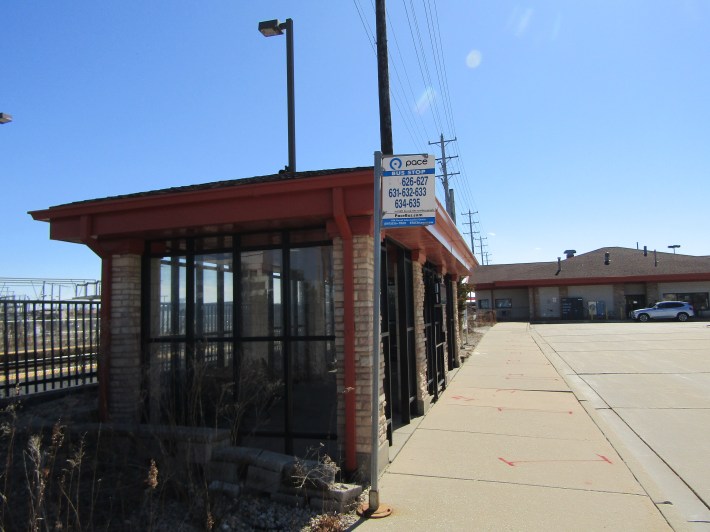
My Commute also wants to study service changes on routes 471 and 472 - Highland Park – Highwood to reduce duplication, and study the future of Route 626. That route used to operate as a "spine" for the Shuttle Bugs, linking the Lake Cook corridor offices to Metra stations and the CTA's Dempster-Skokie Yellow Line station. But Route 626's ridership is currently less than half of pre-pandemic numbers, and the plan questions whether there’s even a market for it.
Regarding bike and pedestrian access, the plan has long lists of short-term improvements. Notably, it recommends reducing or outright eliminating the 20-percent local match requirement for projects that receive county funding, which the study says is too "burdensome" for some municipalities. It recommends prioritizing filling in bike path gaps and making sure there are good-quality sidewalks at bus stops and major corridors. The study does not prioritize streets that already have a sidewalk and/or a bike trail on one side.
The plan recommends building upon the Grayslake Bike Share program to create something countywide. It calls for using some form of public-private funding to set up DIY bike repair stations at trail junctions, schools and colleges, Metra stops and major corporate offices. Any new trails would need to include repair stations, but only if there’s room for them.
Regarding transit-oriented development, My Commute recommends providing grants to help municipalities to create transit-oriented development plans for their local Metra stations, and to update any plans that might be outdated. And while Lake County would like to encourage communities to reduce parking requirements and allow for denser housing, the study acknowledges that the county can only suggest those changes, non enforce them, since zoning is a local matter.
Learn more about the MY Commute Lake County Study here.

Did you appreciate this post? Please consider making a tax-deductible donation to help Streetsblog Chicago keep publishing through 2025. Thank you.
Stay in touch
Sign up for our free newsletter
More from Streetsblog Chicago
Johnson appoints one West Side pastor to CTA board, then nominates another West Side pastor for RTA board
Supporters argue that, despite his lack of transit expertise, Ira Acree’s social justice experience and political connections could be an asset for the RTA board.
Today’s Headlines for Thursday, April 26
The de-facto ban on riverwalk biking is back. What should we do about it?
In the short term, new signage is needed to designate legal areas for cycling on the path. In the long term CDOT should build the proposed Wacker Drive protected bike lane.


